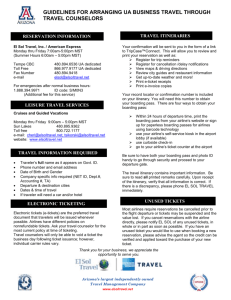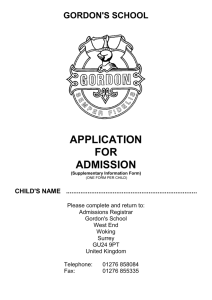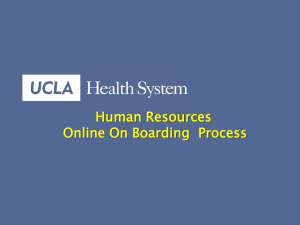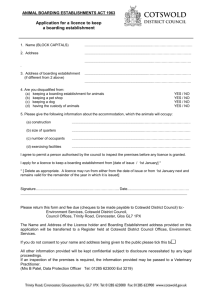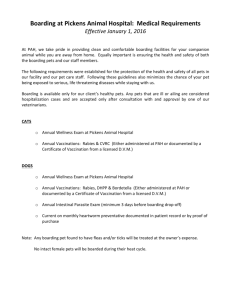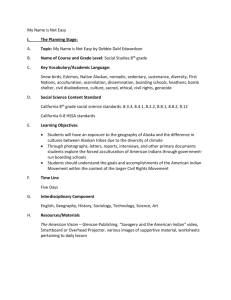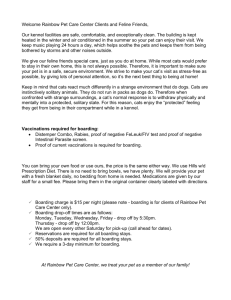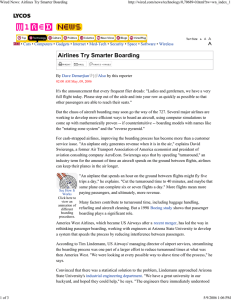108 - NYU Stern School of Business
advertisement
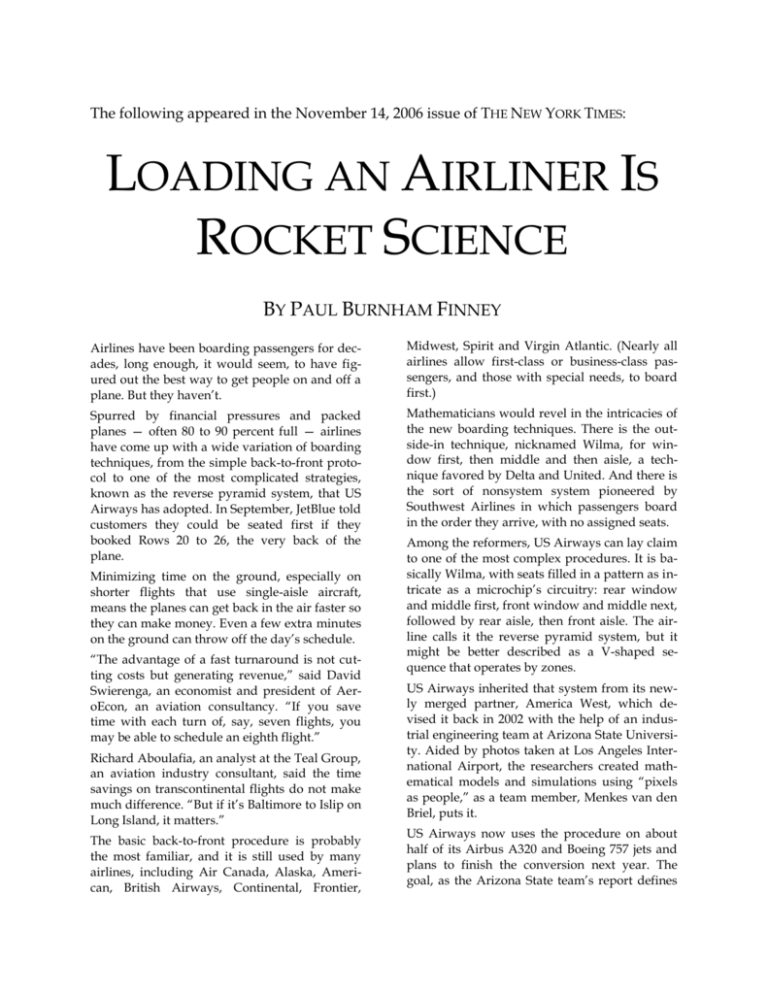
The following appeared in the November 14, 2006 issue of THE NEW YORK TIMES: LOADING AN AIRLINER IS ROCKET SCIENCE BY PAUL BURNHAM FINNEY Airlines have been boarding passengers for decades, long enough, it would seem, to have figured out the best way to get people on and off a plane. But they haven’t. Midwest, Spirit and Virgin Atlantic. (Nearly all airlines allow first-class or business-class passengers, and those with special needs, to board first.) Spurred by financial pressures and packed planes — often 80 to 90 percent full — airlines have come up with a wide variation of boarding techniques, from the simple back-to-front protocol to one of the most complicated strategies, known as the reverse pyramid system, that US Airways has adopted. In September, JetBlue told customers they could be seated first if they booked Rows 20 to 26, the very back of the plane. Mathematicians would revel in the intricacies of the new boarding techniques. There is the outside-in technique, nicknamed Wilma, for window first, then middle and then aisle, a technique favored by Delta and United. And there is the sort of nonsystem system pioneered by Southwest Airlines in which passengers board in the order they arrive, with no assigned seats. Minimizing time on the ground, especially on shorter flights that use single-aisle aircraft, means the planes can get back in the air faster so they can make money. Even a few extra minutes on the ground can throw off the day’s schedule. “The advantage of a fast turnaround is not cutting costs but generating revenue,” said David Swierenga, an economist and president of AeroEcon, an aviation consultancy. “If you save time with each turn of, say, seven flights, you may be able to schedule an eighth flight.” Richard Aboulafia, an analyst at the Teal Group, an aviation industry consultant, said the time savings on transcontinental flights do not make much difference. “But if it’s Baltimore to Islip on Long Island, it matters.” The basic back-to-front procedure is probably the most familiar, and it is still used by many airlines, including Air Canada, Alaska, American, British Airways, Continental, Frontier, Among the reformers, US Airways can lay claim to one of the most complex procedures. It is basically Wilma, with seats filled in a pattern as intricate as a microchip’s circuitry: rear window and middle first, front window and middle next, followed by rear aisle, then front aisle. The airline calls it the reverse pyramid system, but it might be better described as a V-shaped sequence that operates by zones. US Airways inherited that system from its newly merged partner, America West, which devised it back in 2002 with the help of an industrial engineering team at Arizona State University. Aided by photos taken at Los Angeles International Airport, the researchers created mathematical models and simulations using “pixels as people,” as a team member, Menkes van den Briel, puts it. US Airways now uses the procedure on about half of its Airbus A320 and Boeing 757 jets and plans to finish the conversion next year. The goal, as the Arizona State team’s report defines it, is “to minimize the total expected number of seat and aisle interferences.” So far, the system has cut US Airways’ turnaround time by two to five minutes, said a spokeswoman, Valerie Wunder. ple have an innate capacity to “self-organize” and keep out of each other’s way. Because behavior is so hard to predict, some argue that changing boarding procedures is less effective than other tactics, like limiting carry-on baggage. AirTran Airways, a discount carrier, uses a simpler variation. “We divide the plane into six different sections in a rotating zone system,” a spokeswoman, Judy Graham-Weaver, said. Business class fills up first, along with specialneeds passengers. Then the airline begins the seating sequence with the back five rows called first, the front five behind business class second, the next back five rows third — continuing until the rows meet in the middle. “To simplify and improve boarding, the only way is to limit the amount of carry-on baggage,” said Patricia A. Friend, president of the Association of Flight Attendants. “As long as people hold up the boarding process — stowing as much as they can get away with — it’s going to be slow boarding and even slower deplaning.” The recent security crackdown that tightened limits on carry-on luggage serendipitously proved her point. Some airlines said boarding had become noticeably easier because many carry-ons ended up as checked baggage. What is the advantage? One zone is stowing bags while the next zone some distance away is getting settled — and the zones tend not to interfere with one another, Ms. Graham-Weaver said. Perhaps the simplest approach is the open seating plan famously practiced by Southwest Airlines since its earliest days in 1971. It may seem slightly quaint next to its more elaborate cousins, but it has helped make Southwest a turnaround champion that claims to take only 25 minutes on average to unload, clean and reload its 137-passenger Boeing 737s. The variable that keeps upsetting the airline industry’s careful planning is the unpredictability of human behavior. The industry calls it “interference,” and it means time-killing activities like elderly passengers perching on armrests to stuff a bag into the overhead bin. “That’s very fast,” said Mr. Swierenga, the consultant, adding that there are no industry benchmarks on turnaround time. “It depends on the size of the aircraft,” he said. “A 747 jumbo can take hours.” “The unexpected behavior of passengers can lead you to chaos theory for an explanation,” Mr. Aboulafia said. “That’s when random events set off a sequence of unpredictable actions and your best-laid plans go out the window.” But some boarding experts note that peo- Southwest’s turnaround time is “below those of our competitors,” said a Southwest spokeswom- 2 an, Beth Harbin, who added that the range is 35 minutes to an hour for most airlines. book at the last minute without losing out on a good seat,” said Ms. Harbin, the Southwest spokeswoman. “But after going electronic with boarding passes, we cleared at least the technology hurdle of how to assign seats.” Southwest is adamant about not altering its boarding system until at least 2008. Southwest’s system is also cheap and uncomplicated, requiring almost no exotic technology. Customers get assigned to Groups A, B or C on their boarding passes, in the order in which the passenger checks in. Groups are called in alphabetical order, with passengers rushing to occupy the seat of their choice. Northwest, which has traditional assigned seating, recently replaced its back-to-front loading with Southwest-style open boarding. Some corporate travel managers have complained that their fliers are getting the Southwest open-seating treatment even though they are paying full fare. But Northwest, like most major airlines, provides a separate boarding lane for elite business travelers, even when they are late to the gate. And it says its system reduces boarding time by seven minutes. Though some Southwest passengers liken it to a cattle car, they are generally good sports. But in blogs and other forums they grouse that they have to be at the airport early to get the best seats. To show off the effectiveness of its simple system, Southwest’s scheduling department has come up with a what-if model, in which turnarounds take five minutes longer. To keep its current schedules of 2,773 daily turns for its fleet of 461 737s, the airline would need 18 additional aircraft costing a total of $972 million — not including the cost of crews and maintenance workers. So which boarding technique works best? There are skeptics who scoff at all the hand-wringing and research experiments and contend that all these attempts at saving time are a waste of time. Southwest has quietly done tests of so-called dual jet bridges in Austin and Dallas to accelerate boarding by loading passengers through two doors at once. But the bridges proved to be unreliable. The airline does use a different kind of dual bridge in Albany, but has found it only marginally better than single bridges. “The airlines are looking for a new time-saving idea they can believe in and reduce it to a computer code,” said Robert W. Mann, an aviation consultant in Port Washington, N.Y. “Just say, ‘It’s time to go’ and random boarding will get the same result as any systematization.” Last summer Southwest began experimenting with assigned seating, Wilma-style boarding and other loading methods on flights out of San Diego because of the variety of short, medium and long-haul flights there. So far, passengers polled by Southwest are evenly divided between leaving open-seating alone or changing it. “Our fliers are passionate about what they like — for instance, the fact they can 3

